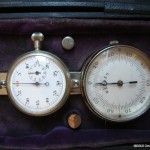As I was starting to organize all of the assorted objects that are not kites, for the annual trip to the Nevada/California desert for this year’s NABX (North American Buggy Expo), I had to rummage through a variety of things in the “back room”. I religiously use my buggy one a year, rain or shine, so sometimes I might forget what, exactly, has been placed in “storage”. While rummaging, I found an object that had been relegated to the back room, and it made me think of the kiteflyer of 100 year’s ago.
Would he have had an automobile? If so, space for other-than-kites would have been at a premium. He would have had kite line and reels, ground anchors, protection from the weather, food, and drink. He might have had hunting kites – used to flush game birds or maybe to keep them on the ground so his dog could do the work! I’m pretty sure several of the the Aigloplan kites could have been used this way.
I won’t have hunting kites with me, but the rest is not unlike the list of stuff that’s going with me to Ivanpah Dry Lake Bed: tent, sleeping bag, chairs, buggy bag with helmet and pads, tools, spare parts, and so forth. (See NABX.net for details on this year’s event)
But the well-appointed gentleman kiteflyer might also have had the latest wind indicator: the Freres Richard Anemometre (Richard Brothers’ Anemometer). Here was an instrument that could accurately measure wind velocity in meters-per-second. Made of heavy chromed steel, it includes a stopwatch with sweep-second-hand as well as the wind indicator with two hands. It could measure meters-per-second to the 100th of a meter!
The well-appointed kiteflyer of today has even more technology at his fingertips: and it comes in an even smaller package. With an iphone and the application called Wind Meter (duh), the flyer can accurately find windspeed recorded in mph, knots, kph, meters per second, feet per second, or Beaufort. Amazing!
But it gets better; with the app called WindAlert, and connection to the “interweb”, you can actually see the wind forecast for your location. This is a great tool for the flyer who wants to waste no time waiting for wind, instead he’s the one who arrives on the field right when the wind gets good. Of course this technology isn’t foolproof, you’ve got to be in a location with electronic access and, the forecasts have to be accurate. Certainly, though it’s a great way to double-check what you see out the window.
So, back to packing and I’ll leave the anemometer in the back room. This time.
Scott Skinner





